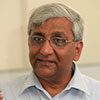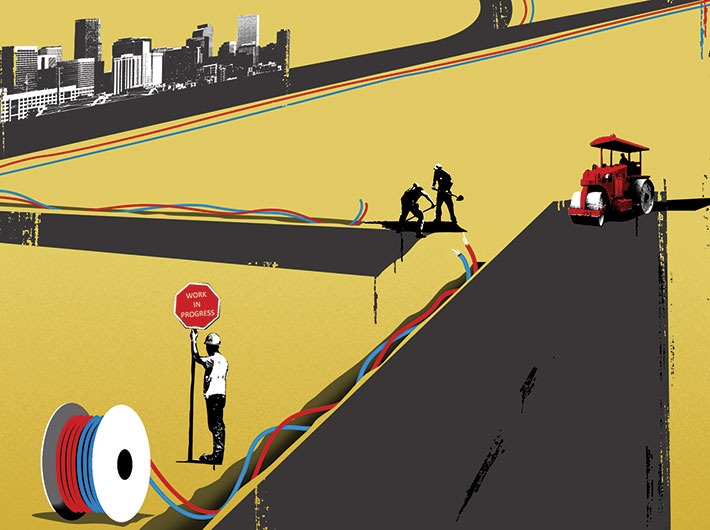By integrating the construction of roads and telecommunications infrastructure, a new cost-effective model of implementation and governance can be evolved
Information and communication technology (ICT) has impacted billons of people in the shortest possible time. Appreciating its enormous potential, the central and state governments in India are increasingly using ICT in all aspects of governance; and its success in many sectors is visible.
Roads are recognised as important assets for economic growth and nation-building. For more than a decade the government has given considerable attention to improving and developing the road infrastructure. Modern technology and metrics are being followed for road asset management and it is largely the basis of the recent assertion that the government has achieved its target of adding 17 km of highways per day.
Some salient examples of ICT deployments are the use of robust software applications specifically developed using highways design guidelines and formulas, wireless communication and sensor technology-based road safety measures, automatic toll collection, e-portal to create a web-based interaction platform for the multitude of stakeholders of the road sector, geographical information system (GIS) for cost-effective and optimal design, construction and maintenance of roads and management information system (MIS) for informed decision-making.
One of the essential elements in ICT-isation of a nation is the availability of high-speed telecommunication network across the length and breadth of the country. Similar to the traditional road highways, the economic growth of a nation in this cyber age also rides on the information superhighway. Since the advent of the high-speed data communication technology through physical media like optical fibre cable (OFC) every nation is striving to spread the telecommunication network. Research reveals that a 10 percent growth in a country’s telecommunication network would result in a one percent growth in GDP.
Till about 1995, in India, telecommunication network was largely based on copper media. However, wireless network based on microwave transmission technology was also being used. This comparatively low-speed copper-based communication network is now being steadily replaced by the OFC-based network across the country.
After the declaration of the ambitious national optical fibre network (NOFN) scheme, and the consequent creation of Bharat Broadband Network Limited (BBNL) under the department of telecommunications (DoT), there has been a concerted effort to set up high-speed OFC-based telecommunication network. The objective is to reach out to 2,50,000 panchayats. However, due to difficult geographical terrain in remote parts of the country, laying OFC has been a time-consuming and costly affair.
In many of these difficult terrains the OFC cables are laid overhead using power transmission poles. This opens a level of vulnerability for the security and safety of the cable.
India has 33 lakh kilometres of road network. Highways, which constitute about only 1.7 percent of this road network, carry about 40 percent of the total road traffic. To correct this skewed situation the government is enhancing the traffic-worthiness of state highways and district roads. To enhance economic inclusion, by way of promoting access to economic and social services and thereby generating increased agricultural incomes and productive employment opportunities as an ingredient of sustainable poverty reduction, the Pradhan Mantri Gram Sadak Yojana (PMGSY) plays an important role.
Opportunity in synergy
The commitment of the government, in accelerating development of the road sector and information superhighways, both targeted to the large contingent of remotely located citizens hitherto unreached, brings a unique opportunity to strike a cross-sectoral synergy between these two large-scale cost intensive activities. A national level coordination in the processes of development of roads and communication network would produce a smart infrastructure with a very high cost-benefit ratio never encountered before.
The objective of the NOFN project is to connect 2,50,000 panchayats across the country by 2015. Going by an estimate of 2010, it would need approximately 20 lakh route-km of optical fibre cable (OFC) network to make broadband available in all the panchayats. After the conclusion of three pilots in three blocks, it is understood that we may need to lay about 5 lakh route-km of additional OFC network, to reach 2,50,000 panchayat villages by the three partners: BSNL, PGCIL and RailTel of BBNL.
There is a division in 70:15:15 ratio of workload with BSNL expected to take the largest burden. Prior to initiation of the NOFN project, OFC cables were available mostly up to the block level. It is now expected that much of the additional network would be laid in the rural hinterland. And here lies the possibility of synergy between the NOFN and PMGSY initiatives, which will bring forth a win-win situation for these two cost-intensive schemes.
The first and foremost benefit from this synergy would be substantial saving in the cost of the NOFN project. Both the PMGSY and NOFN projects are centrally sponsored projects.
Therefore any significant cost savings in one of the projects would serve the nation immensely. The budget allocation for PMGSY in the current year is around '22,000 crore whereas the NOFN project has received an initial sanction of '20,000 crore. It is estimated that 60-70 percent of the sanctioned budget for NOFN will be required for digging trenches for laying the conduit of the OFC cables. Hence, there is a possibility of significant saving in the excavation work, provided the requirement of trenches for laying OFC conduits is suitably incorporated in the design specifications for the roads.
This will significantly bring down the per kilometre cost of fibre deployment. However, an initiative like this would require significant coordination at an appropriate level in the two departments, of telecommunications (custodian of NOFN project) and of rural development (custodian of PMGSY). If this happens, there would not be any need for BBNL or any of its partners to go through the complicated bidding process for creation of cable ducts.
Crossing the biggest hurdle
One of the important issues linked to the last-mile connectivity relates to the right of way (RoW) that is required to be obtained by the telecom service providers (TSPs) from the local or state authority to lay the OFC cables. The issue of RoW has been a big barrier in the way of fast development of the telecom network in our country. Most of the states or local governments think of TSPs as cash cows as they charge significant amounts in lieu of conferring RoW to lay the OFC cables. Other than the significant cost to be incurred in the RoW process, the clearance often take a while, which causes time and cost overruns. Therefore, if the rollout of OFC is allowed as part of the road construction project by providing trenches alongside the roads then this perennial problem of RoW can be resolved for good.
Providing free trenches to the TSPs to lay the cable may also create a win-win situation in favour of the public works department (PWD). It is possible to evolve a suitable business model for PWD in this regard. In lieu of the RoW, the TSPs may provide free dedicated bandwidth at a specific speed to PWD offices spread across a state. Such a wide area network (WAN) would enable the PWD to implement electronic governance for the department’s functions for increased efficiency and better informed decisions. Moreover, such networking at a competitive cost would strengthen overall institutional framework, including transportation systems, as this would improve tracking and tracing of the entire multimodal transport logistics chain, especially in respect of sensitive goods. As for best practices, this model of allowing free bandwidth to PWD and transport department by the TSPs is followed in some states in the US and Jamaica.
Creating smart infrastructure by way of cross-sectoral coordination is the order of the day and this is being followed by many nations. Coherent terrestrial connectivity, involving all relevant infrastructure sectors, can boost competition, lower prices and promote reliable, quality services. A large number of countries are now promulgating appropriate legislation that would promote and facilitate coordinated development of road, ICT and other utilities.
In the US, a presidential executive order was issued on June 14, 2012 on ‘Accelerating Broadband Infrastructure Deployment’ involving 11 federal and state government agencies which would pave the way to create smart infrastructure across USA, taking care of the requirements of all these stakeholders and mandating the norm of ‘dig-once requirements’. The Republic of Korea has promulgated the National Land Planning and Utilisation Act in which Article 44 relates to Installation and Management of Utility Tunnels mandating that any utility tunnel would be installed in a manner that all necessary facilities are available in such a tunnel without omission.
There is a natural logic in advocating synergy between telecommunication and road networks as they share the same mesh architecture, making comprehensive inter-city communication easy. On the other hand, implementation models prevalent now for projects in these two sectors are also offering options for diversifying innovative public-private partnership between government and the private implementer.
As far as funding for such an ambitious project is concerned, the country needs to cross a major hurdle — that of cross-sectoral synergy. Once this is established, the funding proposals can be better evaluated by the government or any private or multilateral funding agency, as the sector-wide project risks would be better appreciated.
While the need for a better coordination is well understood, efforts are being made to build in more synergies between the various infrastructure entities — PWD, telecommunication, water, gas, rural electricity, etc — that are essential to create smart infrastructure for citizens of a modern nation. A committee headed by the telecom secretary is also looking into the means to coordinate BBNL’s business development and bandwidth demand aggregation. BBNL also has an alliance with the ministries of rural development, panchayati raj, HRD, health and family welfare and women and child development to promote the utilisation of NOFN.
However, it is high time that government extends the ToR for such alliances and committees to seriously deliberate on the synergy between telecom and road sector. This will help create smart and cost effective infrastructure.

